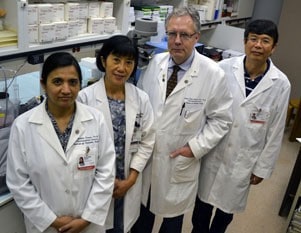UAMS Researchers Make Breakthrough in Radiation Protection
June 26, 2012 | Researchers at the University of Arkansas for Medical Sciences (UAMS) have shown for the first time that boosting a protein pathway in the body’s circulatory system can act as protection against potentially fatal radiation poisoning. The breakthrough was published online June 24 in the prestigious journal Nature Medicine and the abstract can be found by entering the code “10.1038/nm.2813” here: http://dx.doi.org/. The full paper is available upon request. The study holds the potential for new treatments against radiation toxicity during cancer treatment or environmental exposures, such as a nuclear explosion or accident. The UAMS team was led by Martin Hauer-Jensen, M.D., Ph.D., senior author of the paper. He is associate dean for research, director of the Division of Radiation Health in the UAMS College of Pharmacy and staff surgeon at the Central Arkansas Veterans Healthcare System. The work was performed as a multi-institutional collaboration with Hartmut Geiger at Cincinnati Children’s Hospital Medical Center and the University of Ulm in Germany, and Hartmut Weiler at the Medical College of Wisconsin and the Blood Center of Wisconsin. “Our study identifies a target-specific intervention that protects the system against radiation toxicity, which largely is an unmet challenge,” Hauer-Jensen said. “Current treatments for radiation, such as blood transfusions or growth factors, don’t help blood-making cells survive radiation toxicity. They can only help expand what is still there. The advantage we’ve discovered is the ability to protect blood-making cells after they have been irradiated.” Hauer-Jensen said the finding is the culmination of more than 15 years of his focus on a naturally anticoagulant molecule called thrombomodulin (Thbd). The researchers began by looking for novel genes and molecular pathways that protect blood-making cells from radiation injury. They identified a natural cell surface receptor called Thbd, which helps regulate a number of cellular processes, including in the blood-making system. Thbd binds the protein thrombin in blood-forming cells. This forms what is known as the Thbd/thrombin complex, activating another protein, protein C. The Thbd/thrombin/protein C system has a number of functions, including helping the body promote the production, migration and healthy function of blood-forming cells. The study showed a remarkable success rate in the lab against deadly doses of radiation when treated with a soluble form of Thbd or activated protein C, even when the treatment was started after irradiation. “Radiation injury is very complex” said Daohong Zhou, M.D., deputy director in the UAMS College of Pharmacy Division of Radiation Health and co-author on the article. “I think even though many studies have been done, we still know very little about how to intervene after an organism has been exposed to radiation. This new pathway identified by Dr. Hauer-Jensen and his collaborators for the first time helps clear the picture about radiation injury and protection.” Hauer-Jensen said the finding could potentially revolutionize the way radiation exposure is treated. Junru Wang, M.D., Ph.D., an assistant research professor and Snehalata Pawar, Ph.D., an assistant professor, as well as Qiang Fu, M.D, Ph.D., a former assistant research professor, all in the UAMS College of Pharmacy Division of Radiation Health, also contributed to the study. Also key to the paper’s findings were researchers from the Scripps Research Institute in La Jolla, California; the Hannover Medical School in Germany; the Desert Research Institute in Las Vegas; and PAION Deutschland in Aachen, Germany. The research was funded by the National Institutes of Health and the Veterans Administration. |
